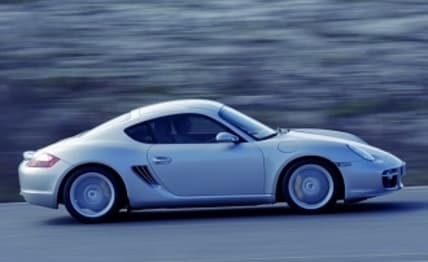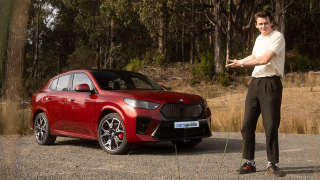
Porsche Cayman 2008 review
- Porsche Cayman
- Porsche Cayman 2008
- Porsche Cayman Reviews
- Porsche Reviews
- Porsche Coupe Range
- Coupe
- Porsche
When the Cayman was first revealed by Porsche in 2005, it was to a mixed reception. There were those who loved the idea of a mid-engined model to sit just above the Boxster, and there were those who saw it as ... well, just another Boxster.
But, despite the detractors, it was a good little car — attractive, dynamic and powerful enough to attract a lot of new buyers into the brand.
Now it’s an even better little car, with new engines and suspension set-up, tweaked jewellery, better economy and the option of Porsche’s twin-clutch transmission to really sweeten the deal.
Drivetrains
Porsche has put a lot of effort into reducing the weight and friction levels of both new engines to boost power while reducing fuel consumption.
The base model Cayman gets a 195kW/300Nm 2.9-litre six-cylinder boxer engine (up 200cc and 15kW). Mated to a new manual transmission with six slots over the previous five, this gives a 0-100 speed of 5.8 seconds, which is shaved by 0.1 if you option the PDK box – the downside being 2km/h also being shaved off the manual’s top speed of 265km/h due to weight gain. But while the manual uses 9.2L of fuel per 100km, the new transmission manages 8.9 — an improvement of 11 per cent on the outgoing model with its sequential Tiptronic.
The Cayman S carries a direct fuel-injected 3.4-litre six-cylinder that develops 235kW (up 18kW). With the six-speed manual you get a 0-100 speed of 5.2 seconds, but getting the PDK here gets you down to 5.1 – and with the optional Sports Chrono Pack drops down to a blistering 4.9 — but again cuts 2km/h off the manual’s top speed of 277km/h. And again the PDK offers fuel savings on the previous Cayman S, using 16 per cent less at 9.2L/100km, while the base model comes in at 9.6L/100km.
Appearance and equipment
There has been little change to the body styling of the Cayman, but it has been freshened at nose and tail with light clusters featuring twin tube halogens at the front and LED strips at the back that accentuate the swelling curves of the haunches, a new wind deflector plate and foglights. To dress up further, there’s an optional lighting pack with bi-xenon lamps and LED daytime running lights.
Porsche says these changes have been made while maintaining the Cayman's aerodynamic drag figure of 0.29 and downforce — increased by the split wing spoiler moving up 80mm when the car hits 120km/h.
The interior gets some facelifted touches, the main one being a revised centre control stack with larger screen for nav, info and entertainment. And ventilation has been added to the heating for the perforated-leather covered seats. And you could almost claim it’s practical too, with a 410-litre luggage capacity, although there’s little in the way of cabin storage to augment that for smaller items, and the cupholders that spring out of the dash are a nightmare.
Underpinnings
The Caymans roll on new wheels — 17” and 12mm wider on the base model, which now gets the larger 318mm front and 299mm rear brakes of its big brother — and 18” on the S, with the chance to upgrade to 19” and also nab the awesome 350mm ceramic brake package plus a locking rear diff. But in Porsche tradition, there's no spare wheel, simply a can of tyre sealant and a compressor — and perhaps a prayer for our councils to sweep the streets more often.
Meanwhile, new mapping has given the steering a sharper response, while the suspension has been adjusted to account for the engines’ extra power.
Porsche’s electronically controlled Active Suspension management is available for both models, lowering the body by 10mm over the standard suspension. It has been enhanced with brake assistance that includes a pre-loading function that comes into play if you lift off the accelerator quickly – even before your foot touches the brake pedal.
The Sports Chrono Package adds a Sport Plus function that further sharpens steering, quickens gearchanges and throttle response and hardens the suspension. And if you’ve got the PDK box, the Chrono addition tosses in a Launch Start function — where you can look like Lewis Hamilton by plunging your feet onto both pedals, revving up and then wiping your foot off the brake and letting the car slingshot you into the horizon — as well as a handy auto kick-down if you stab the accelerator.
There have been some weight losses and gains overall, with the Cayman tipping the scales at 1330kg with the manual box and 1360kg with the PDK, while the S is 1350kg with the manual and 1375 with the PDK.
This means the S with PDK comes in at 15kg lighter than the previous model with the Tiptronic, but the base model has gained about the same mainly because of the extra gear and larger brakes.
Pricing
Final Australian spec and the price tags are yet to be revealed, and we should have more information close to the car’s local launch in March 2009.
Driving
On the road the Cayman S we tested was a joy. The engine is keen to let you dip into its extra sauce, and just keep pouring it on, delivering it in a smooth progressive stream with no sign of it letting up as it swings the needle up to the 7500rpm redline.
And it sounds better too – with Porsche saying they retuned the exhaust specifically for that effect. But it still falls short of the kind of guttural growl that vibrates through your stomach lining when you’re in something like the 911 Carrera.
On the noise side, there’s quite a bit of wind rush, and a lot of tyre noise over rougher surfaces.
But those same bits of bad road revealed the remarkable qualities of the new suspension set-up. Patchy bitumen, gaping potholes – no matter what the semi-rural roads on the southern Spain launch threw at it – the Cayman S simply snubbed its nose at the challenge. You could hear it all passing under the wheels, but there was little in the way of jarring or jumping that upset the handling – or the occupants.
One question we always have of suspensions designed with European markets in mind is whether or not they will handle our poor Aussie blacktop well enough. In the case of the Cayman, the answer is a resounding `yes’.
It tracks confidently and the wide stance helps keep it glued to the road.
Pressing the Sports Plus button sharpened everything up to near-race track standards – but in this case the car became almost too responsive to joust with oncoming farmers on the narrow winding mountain roads.
With the PDK predicting which gear you want to be in next and getting it set up for you, once you get used to thumbing the forward-back paddles wrapped around the spokes of the steering wheel, this car is simply a bundle of fun that makes the most of its power-to-weight ratio.
No, it’s not a 911. But then, only a 911 is a 911. But what it is – especially in the current economy – is a fantastic drive-to-dollar ratio.
Pricing guides
Range and Specs
| Vehicle | Specs | Price* | |
|---|---|---|---|
| (base) | 2.7L, PULP, 5 SP MAN | $25,850 – 31,900 | 2008 Porsche Cayman 2008 (base) Pricing and Specs |
| S | 3.4L, PULP, 6 SP MAN | $29,370 – 35,420 | 2008 Porsche Cayman 2008 S Pricing and Specs |
$29,370
Lowest price, based on third party pricing data























